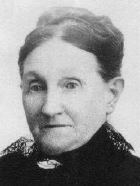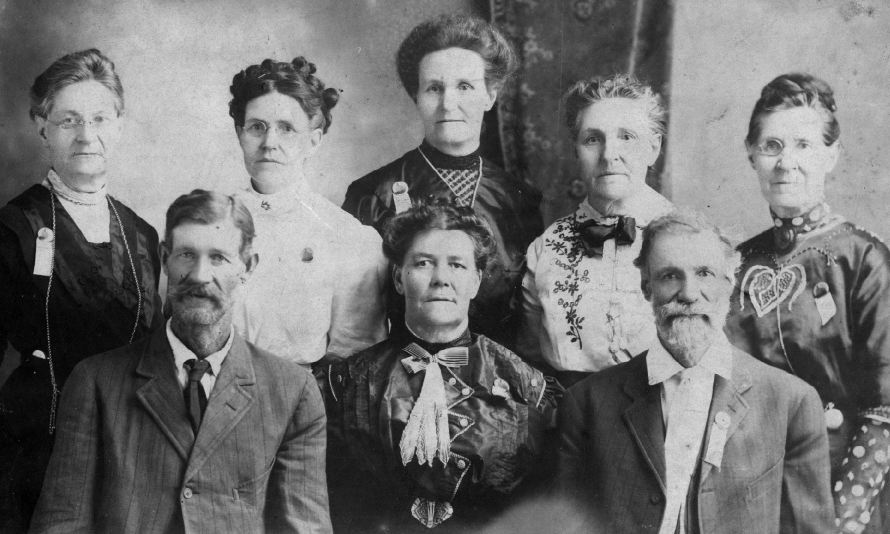Sarah Ann Pulsipher (1824-1909)
 |
Husband: John Alger |
11 Children:
Nelson Alger (1843-1848)
Sarah Ann (Surry Ann) Alger (1845-1933)
Olivia (Ollie) Alger (1847-1930)
Adeliza (Addie) Alger (1849-1925)
John Zera Alger (1852-1933)
Martha Ellen (Ella) Alger (1853-1934)
Ann (Annie) Alger (1856-1945)
Samuel Nelson Pulsipher Alger (1858-1911)
Alva Don Pulsipher Alger (1860-1898)
Willard Edgar (Will) Alger (1862-1947)
Mary Edna (Mame) Alger (1865-1946)
|
Father: Zerah Pulsipher
Mother: Mary Brown

|
Sarah Ann Pulsipher was born 2 Nov 1824 in Stafford, Onondaga Co., N.Y., the fifth child of
Zerah and Mary Brown Pulsipher. The family had moved there from Pennsylvania in late 1823 or
early 1824 and bought a farm and built a mill.
Sarah was seven years old when her parents heard the restored gospel and were baptized into the
LDS Church. In March, 1834, elders from Church headquarters in Kirtland came
to visit recruiting volunteers for Zion's Camp. Her father was the Branch President and
little nine-year-old Sarah is listed in the records as having been one of only seven children
who went on that military expedition (DHC 2:185). Her father did not go.
When she was 10, the family moved to Kirtland, Ohio, in spring 1835, so she
would have remembered those times well.
Persecutions drove them to Nauvoo, Illinois, and there she met John Alger, the son of Samuel and
Clarissa Hancock Alger, who was four years older than she. At age 18 she married him in the
Nauvoo Temple on Sun, 13 Feb 1842. About 1843 they had a son named Nelson, the name of her
older brother who was killed at age 4 by a falling tree, but this Nelson also died young. Then
Sarah Ann, known throughout life as "Surrie Ann" was born on 13 Apr 1845 in Nauvoo.
Shortly afterward, persecutions drove them from Nauvoo to cross the plains for the Salt Lake
Valley. While at Winter Quarters, Nebraska, Olivia (Ollie) was born on 23 Jun 1847. Just as they
were arriving at Salt Lake City, Sarah gave birth to Adeliza (Addie) on 9 Aug 1849. As the young
couple struggled to establish a home there, John Zerah was born 15 Jan 1852, Martha Ellen (Ella)
on 4 Dec 1853, and Ann Eliza (Annie) on 20 Dec 1855.
In 1857 Johnston's Army was determined to enter the peaceful valley of the Saints. Sarah
experienced many anxious hours as her husband went with the other men into the mountains to
thwart the plans of the enemy. The inhabitants of the city had been instructed to move south out of
the way of the intruders, should they get by the guard. At this time Sarah was expecting another
child and hence it was in Payson, Utah, that Samuel Nelson was born 26 Apr 1857. After the
trouble passed, they moved back to Salt Lake where Alva Don (Don) was born 21 Jan 1860 and
Willard Edgar (Will) on 11 Apr 1862.
In the fall of 1862 they were called to reinforce the settlements far to the south in Utah's Dixie.
Sarah was happy to learn that her parents and all of her sisters and brothers had also accepted a call
to do likewise. They began making preparations right after that October Conference and arrived at
their new location in St. George, Utah on 1 Jan 1863.
 |
Eight of Sarah and John's children:
Back, L-R: Addie, Mame, Ann, Ollie, Surrie Ann
Front, L-R: Will, Ella, John
Her parents, Zerah and Mary Pulsipher, soon established Shoal Creek, later called Hebron, and
John and Sarah moved there with their family. At Hebron, Sarah's eleventh and last child was
born, Mary Edna (Mame), 9 Dec 1865. The family later moved to St. George and established a
permanent home there. She died there on 1 Jan 1909, at age 84, on the 46th anniversary of arriving
in St. George.
Her grandchildren provided the most interesting part of this sketch:
"I think Grandma was about five feet and two or three inches tall. She would have weighed about
120 or 130 pounds after she got old. She was very erect and dignified and proud in her carriage.
She had good articulation in her speech. I loved to listen to her talk."
"She had beautiful hair, even when she died, not very grey. Grandma said every few weeks she
rubbed coal oil and salt into her scalp, then fine combed it. She was a great hand to have the
children comb her hair. If she ever caught a youngster idle, she'd hand them a fine comb and take
down her hair and they'd have a job as long as they'd comb. My oldest daughter, Cecil,
remembers combing her hair when she was just a little tot."
"Grandma was a good hand at teaching youngsters to learn to dress themselves. I guess I was
spoiled and pampered being the only girl. I used to bawl around for Ma to come and dress me but
one morning Grandma turned on me and said, `You are a big girl now and your Ma is not going to
dress you any more' and she didn't!"
"We were at Aunt Addie Price's home in St. George when the first automobile came into St.
George. Aunt Addie came calling to us to `Come quick, the automobile was coming up the street.'
Grandma passed us all and was out on the sidewalk cheering that new invention. She was always
interested in improvements of any kind."
"Grandmother was a very proud, dignified lady. I can't ever remember seeing her when she didn't
look like she had just stepped out of a band box. She did very fine needle work. She made a
beautiful silk quilt, a crazy patch, that took first prize at the fair. I remember helping her feed silk
worms. I think she was one of the first to raise them in St. George."
"I remember seeing Grandma Alger wear a black silk dress. She said she raised the silk, spun the
thread, wove the cloth and made the dress by hand. She was a wonderful seamstress. She was
also an expert at making buckskin gloves for ladies. She made hundreds of pairs. My mother had a
pair of her gloves. I can remember they had high gauntlets, all silk embroidered. They were
lovely."
"I do not remember ever being at Aunt Addie's place while Grandma lived there without there
being Indians and usually a yard full of them around. They would bring pine nuts and jerky or
buckskin to trade for medicine. She made excellent buckskin gloves and always got a good price
for them from the white folks. Sometimes the Indians would just sit on the ditch banks or steps in
the shade just because they felt at home around there. The squaws did the laundry for Aunt Addie.
Grandma made most of her own medicine, usually pills. She had a pension from the U.S.
government when she was old for doctoring the Indians."
"She was always telling about something that happened on their trip across the plains. How they
prayed for a safe night's rest when they camped. She told us of a rattle snake going up Grandpa
Alger's leg. It touched his garments at the knee and fell dead at his feet."
"I remember on her 80th birthday they had a party for her. She was dressed all in white and sang,
`Oh, My Father,' besides joining in the games. She was very witty and always had an answer to
everything. She was a temple worker for thirty years. She was very kind to everyone, especially to
the Indians. She had doctored them many times, always preparing her own medicines."
From Pulsipher Family History Book, Terry/Nora Lund, SLC, 1953, pp. 42-46.

